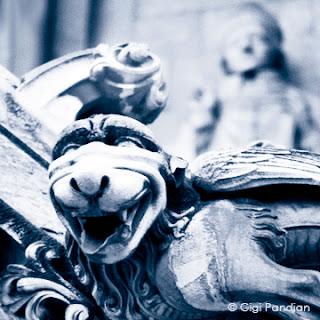Before moving on, one last look at a few of the gargoyles of Notre Dame.
Contrasting last week's photos, below are a few of my more recent photographs of the iconic stone figures on Notre Dame Cathedral in Paris.
These three photos were taken using a lensbaby lens, which is basically a bending plastic tube that you physically push and pull to focus on one tiny "sweet spot" in your field of view. Frustrating, yes. But a lot of fun, too.
I love the possibilities of this lens, but I also miss black and white film. Yes, there's always Photoshop to convert color photos into black and white. Something of the mystery of photography is gone when you can snap hundreds of photos without thinking about it, though. With digital, we often miss out on savoring the few special images we captured on film during a trip.
Whenever I have room in my bag -- which isn't as often as I'd like -- I take my Holga plastic camera with me. It shoots 120 film and takes square pictures. Again, you can always crop a photo in Photoshop, but it's rather magical to frame a photo just as you want it and then see how the light falls in the print you end up with. Maybe I'll find some of my Holga photos to scan for my next post.
-- Gigi
Contrasting last week's photos, below are a few of my more recent photographs of the iconic stone figures on Notre Dame Cathedral in Paris.
These three photos were taken using a lensbaby lens, which is basically a bending plastic tube that you physically push and pull to focus on one tiny "sweet spot" in your field of view. Frustrating, yes. But a lot of fun, too.
I love the possibilities of this lens, but I also miss black and white film. Yes, there's always Photoshop to convert color photos into black and white. Something of the mystery of photography is gone when you can snap hundreds of photos without thinking about it, though. With digital, we often miss out on savoring the few special images we captured on film during a trip.
Whenever I have room in my bag -- which isn't as often as I'd like -- I take my Holga plastic camera with me. It shoots 120 film and takes square pictures. Again, you can always crop a photo in Photoshop, but it's rather magical to frame a photo just as you want it and then see how the light falls in the print you end up with. Maybe I'll find some of my Holga photos to scan for my next post.
-- Gigi











